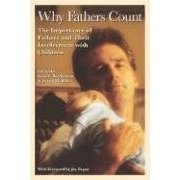 New fathers don’t receive a how-to manual when they hold their little bundle of joy for the first time. The book “Why Fathers Count: The Importance of Fathers and Their Involvement With Children,” provides information and tips for fathers and those who support them at all stages of parenting — from new fathers to grandfathers. It also contains information and insight on fathers and families on a wide variety of topics such as fathers and daughters, fathers and play, working fathers, fathers who are divorced and fathers and a child’s education.
New fathers don’t receive a how-to manual when they hold their little bundle of joy for the first time. The book “Why Fathers Count: The Importance of Fathers and Their Involvement With Children,” provides information and tips for fathers and those who support them at all stages of parenting — from new fathers to grandfathers. It also contains information and insight on fathers and families on a wide variety of topics such as fathers and daughters, fathers and play, working fathers, fathers who are divorced and fathers and a child’s education.
According to the book, the most important work that men do is being totally involved in the lives of their children and families. This contemporary edited anthology focuses on key issues in fathering and father involvement. The book is edited by Sean Brotherson, associate professor of family science, North Dakota State University, Fargo, N.D., and Joseph White, research scientist at the Institute for Research and Evaluation, Salt Lake City, Utah. It is available at http://www.whyfatherscount.com and at http://www.mensstudies.com. [continue reading…]
Whether it be for two hours or an entire day, millions of tweens – children ages 11 to 13 – will be left home alone this summer, despite their parents’ concerns that they may not have the knowledge and skills they need to stay safe at home.
According to a report released today by the University of Michigan C.S. Mott Children’s Hospital National Poll on Children’s Health, many parents worry that their at-home tweens do not know how to safely use kitchen appliances, where to go to stay safe during a severe storm, or that they should not give out personal information online or over the phone. Yet, one in five parents polled say that they have left tweens home alone for an entire day. [continue reading…]
Mothers play an important role in determining how much fathers get involved in taking care of their infants, according to new research.
A study of 97 couples found that fathers were more involved in the day-to-day care of their infants when they received active encouragement from their wife or partner.
In fact, this encouragement was important even after taking into account fathers’ and mothers’ views about how involved dads should be, the overall quality of the couple’s parenting relationship, and how much mothers worked outside the home.
In addition, fathers’ beliefs about how involved they should be in child care did not matter when mothers were highly critical of fathers’ parenting. In other words, fathers didn’t put their beliefs into practice when faced with a particularly judgmental mother. [continue reading…]
This week BPS Research Digest takes a look at aggressive behaviour in children, reviewing Sheehan, M.J., Watson, M.W. (2008) paper, and how parents should avoid exacerbating such behaviour with harsh combative discipline.
Michael Sheehan and Malcolm Watson followed 440 children and their mothers for five years. On four occasions during that time, the mothers answered questions about their own style of parenting and their children’s behaviour. At the start of the study, the children’s average age was 10 years and by the final assessment their average age was 15.
The results revealed two-way influences between children’s behaviour and their mothers’ parenting style. On the one hand, children’s aggressive behaviour at younger ages predicted more disciplining by mothers, including more use of combative discipline (both verbal and physical) and more use of reasoning techniques. On the other hand, a greater use of harsh, aggressive discipline by mothers predicted increased future aggressive behaviour by their children.Â
Link to read this BPS report
Source: BPS Research Digest, Sheehan, M.J., Watson, M.W. (2008). Reciprocal influences between maternal discipline techniques and aggression in children and adolescents. Aggressive Behavior, 34(3), 245-255. DOI: 10.1002/ab.20241
Â
 New fathers don’t receive a how-to manual when they hold their little bundle of joy for the first time. The book “Why Fathers Count: The Importance of Fathers and Their Involvement With Children,” provides information and tips for fathers and those who support them at all stages of parenting — from new fathers to grandfathers. It also contains information and insight on fathers and families on a wide variety of topics such as fathers and daughters, fathers and play, working fathers, fathers who are divorced and fathers and a child’s education.
New fathers don’t receive a how-to manual when they hold their little bundle of joy for the first time. The book “Why Fathers Count: The Importance of Fathers and Their Involvement With Children,” provides information and tips for fathers and those who support them at all stages of parenting — from new fathers to grandfathers. It also contains information and insight on fathers and families on a wide variety of topics such as fathers and daughters, fathers and play, working fathers, fathers who are divorced and fathers and a child’s education.